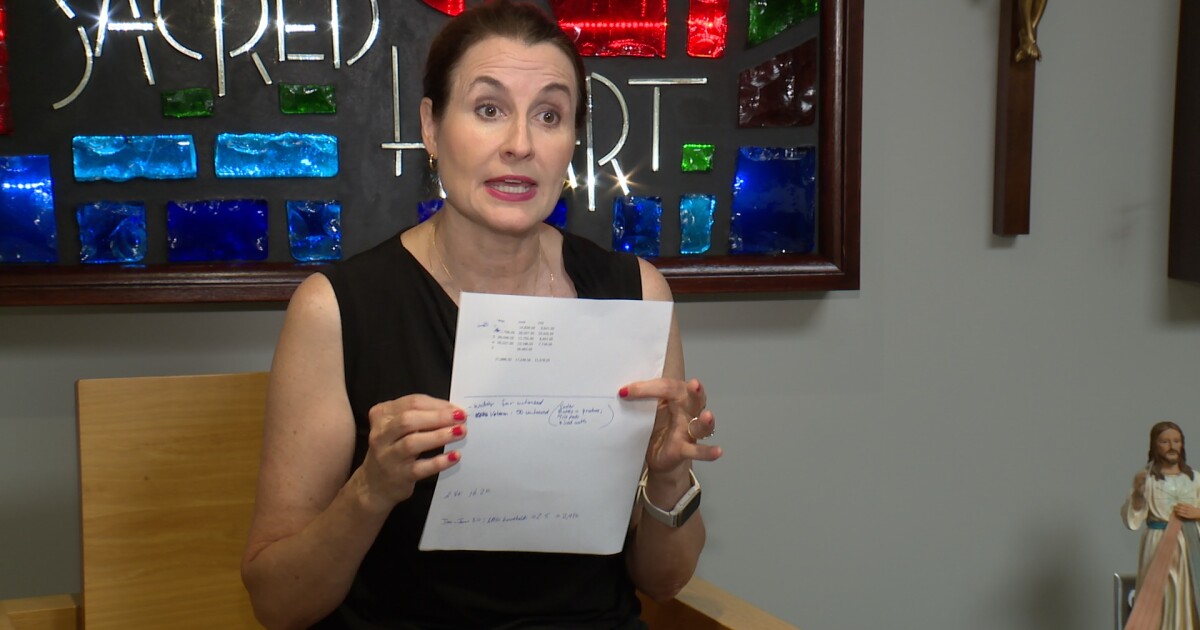New York
Mother and 3 Children Detained by ICE at Upstate N.Y. Farm Are Released

Three children and their mother have been released from federal custody after being detained by immigration enforcement agents last month at an upstate New York dairy farm, officials said on Monday.
The case sent shock waves through tiny Sackets Harbor, N.Y., a village of about 1,400 people on Lake Ontario where the children were enrolled, and well liked, at the town’s school.
The family’s detention was another move amid the Trump administration’s immigration crackdown to touch off protests. About 1,000 people rallied on the family’s behalf on Saturday, according to North Country Public Radio.
The release of the woman and her children — a third grader and two high school students — was announced by Gov. Kathy Hochul, a Democrat, and the local state assemblyman, Scott Gray, a Republican.
“We are open to working with federal immigration enforcement to crack down on gang members or violent criminals,” Ms. Hochul said in a statement. “But I will never support cruel actions that rip kids out of school or tear families apart.”
Mr. Gray said in a separate statement that “we are all profoundly grateful” that the family had been returned to New York.
The mother and her children, who have not been publicly identified, were taken into custody on March 27 after immigration agents arrived at North Harbor Dairy to arrest a South African man sought on a charge of distributing images of child sexual abuse, court documents said.
The man was arrested, and seven other people deemed to be in the United States illegally were detained as well, Thomas D. Homan, the Trump administration’s “border czar,” said last week in an interview with a local TV station, WWNY.
“It wasn’t a raid,” Mr. Homan said in the interview. “It was a search warrant execution at a house where a family was found in the country illegally.”
The family’s supporters disputed that characterization, saying the family had an asylum case pending in immigration court and had kept in close contact with the federal authorities.
Gittel Evangelist, a spokeswoman for the Rural & Migrant Ministry, an advocacy group in New York, said the family was from Guatemala. The New York Immigration Coalition said they had been held at a facility in Karnes County, Texas, since being detained.
The Department of Homeland Security said in a statement late Monday that the family had been detained during the execution of a criminal search warrant “to ensure these children were not being sexually exploited.”
A call to North Harbor Dairy was not returned.
School officials, who helped bring attention to the case, expressed relief about the family’s release on Monday.
“My colleagues and I are thrilled to announce that after 10 days of uncertainty, our students and their mother are returning home,” Jennifer L. Gaffney, the Sackets Harbor schools superintendent, said in a statement.
“In this difficult time,” she added, “the strength and compassion of our community have shone through to support our missing family and the entire school community.”
At the rally on Saturday, supporters of the family gathered in downtown Sackets Harbor before bringing the protest to the doorstep of Mr. Homan, marching to a vacation home he owns in the village.
Jonna St. Croix, a social studies teacher at Sackets Harbor Central School and the president of the local teachers’ union, was among those in the crowd.
The school, which runs from kindergarten through 12th grade, has about 400 students, according to state data. In such a small school, Ms. St. Croix told North Country Public Radio, everyone knew the three children.
“When there is an empty desk in the classroom, it is very evident,” she said. “And we miss them.”

New York
Read the Justice Department’s Epstein Filing

Case 1:19-cr-00490-RMB Document 61 Filed 07/18/25
Page 3 of 4
4.
“It is a tradition of law that proceedings before a grand jury shall generally remain secret.” In re Biaggi, 478 F.2d 489 (2d Cir. 1973). “[T]he tradition of secrecy,” however, “is not absolute.” In re Petition of Nat. Sec. Archive, 104 F. Supp. 3d 625, 628 (S.D.N.Y. 2015). Although Rule 6(b)(3) of the Federal Rules of Criminal Procedure generally lists the exceptions to grand jury secrecy, the Second Circuit has recognized that “there are certain ‘special circumstances’ in which release of grand jury records is appropriate even outside the boundaries of the rule.” In re Craig, 131 F.3d 99, 102 (2d Cir. 1997); see also Carlson v. United States, 837 F.3d 753, 767 (7th Cir. 2016) (“Rule 6(e)(3)(E) does not displace that inherent power. It merely identifies a permissive list of situations where that power can be used.”). One such “special circumstance” is historical interest by the public. In re Craig, 131 F.3d at 105. Under In re Craig, this Court retains discretion to determine “whether such an interest outweighs the countervailing interests in privacy and secrecy[.]” Id.
5.
Public officials, lawmakers, pundits, and ordinary citizens remain deeply interested and concerned about the Epstein matter. Indeed, other jurists have released grand jury transcripts after concluding that Epstein’s case qualifies as a matter of public concern. See Order Granting Plaintiff’s Motion for Reconsideration of the Trial Court’s February 29, 2024 Order, CA Florida Holdings, LLC v. Dave Aronberg and Joseph Abruzzo, 50-2019 CA-014681 (15th Cir. July 1, 2024).³ After all, Jeffrey Epstein is “the most infamous pedophile in American history.” Id. The facts surrounding Epstein’s case “tell a tale of national disgrace.” In re Wild, 994 F.3d 1244, 1247 (11th Cir. 2021) (discussing the plea agreement secured by Epstein in Florida). The grand jury records are thus “critical pieces of an important moment in our nation’s history.” In re Petition of Nat. Sec. Archive, 104 F. Supp. 3d at 629. “The time for the public to guess what they contain
3 https://www.mypalmbeachclerk.com/home/showpublisheddocument/4194/638554423710170000.
3
New York
Read Thomas Donlon’s Lawsuit

New York
Video: Inside Rikers Island: A Suicide Attempt as Guards Stand By

This is the inside of a psychiatric unit on Rikers Island. It’s the morning of Aug. 25, 2022. And soon, this inmate, Michael Nieves, will attempt to commit suicide by cutting his own throat. He’ll bleed out for 10 minutes as officers stand by and wait for medical help. But Michael Nieves is just one of many cases of preventable harm on Rikers Island that ultimately led a federal judge to strip control of the jail from the City of New York in May. Soon, an independent manager will be appointed. After almost three years of filing Freedom of Information requests and lawsuits, The New York Times has now obtained videos of incidents that contributed to this decision, including that of Nieves. They take us inside Rikers, a place rarely seen by the public, and show serious lapses in the care of inmates. A long-serving member of an independent oversight body, who we’ll hear from later, told us that the case of Michael Nieves is characteristic of the problems inside the jail. Here’s what happened. It’s around 11:30 a.m., and a search of Michael Nieves’s cell fails to turn up a shaving razor he was given to use in the shower that morning. Capt. Mary Tinsley, the supervisor in charge, instructs Officer Beethoven Joseph, whose body camera footage we see here, to take Nieves for a body scan to see if he is hiding the razor. But Tinsley grows impatient with Nieves. Officers close the door and walk away. This is one of a series of mistakes that play out. These officers are trained to work with severely mentally ill detainees like Nieves, a once-gifted student who was later diagnosed with bipolar and schizophrenia disorders. Like most inmates on Rikers, Nieves was awaiting trial and had not yet been convicted of a crime. He was arrested on burglary and arson charges in 2019, but was deemed unfit to stand trial and held in forensic psychiatric facilities before being sent back to Rikers. Nieves had a long history of suicide attempts. And even though officers suspect he has the razor, he is left alone for 12 minutes while they search the cell of another inmate. Then Joseph returns, followed by Tinsley. She radios for help. The scene is disturbing, but we’re showing it briefly to illustrate what the officers could see. Nieves has cut his neck and is bleeding heavily onto the floor. Pressure needs to be applied to the wound immediately, and he needs to get to a hospital. At first, Nieves doesn’t respond. And the officers and Captain Tinsley don’t intervene. Officer Joseph faces a complex situation. Jail guidelines do not clearly say he should treat a severely bleeding wound. And officers are advised to use caution when they might be lured into danger. But state law does require him to render care in life-threatening situations. It’s unclear if he recognizes it as such. No one enters the cell. Instead, they offer Nieves a piece of clothing. Five minutes have passed. Officer Joseph asks about the bleeding. Eight minutes have passed. Nieves slides down to the floor. Officer Joseph shows concern, but remains by the door. After 10 minutes, the medics arrive on the ward and enter the cell. But there’s been a communication breakdown. The medics aren’t aware that Nieves is bleeding profusely, and they don’t have the right supplies. As they spring into action, the medics berate the correction officers. As medics render aid, Officer Joseph goes to review his notes and talks with another staff member. About an hour after Nieves was found bleeding, over a dozen medics, staff, and E.M.T.s are treating him on site. Shortly after, he was taken to a nearby hospital, declared brain dead and removed from life support five days later. “This was preventable.” Dr. Robert Cohen is a member of the Board of Correction, which monitors Rikers, and agreed to speak about the jail and the Nieves case in a personal capacity, not on behalf of the board. He retired shortly after this interview. “He should not have been left alone once they believed that he was in possession of a razor. By policy, he should have been taken immediately to the body scanner.” “He was bleeding to death. The correction officer should have gone into the room, assessed what was going on and should have applied pressure to the area where the blood was coming from.” A city medical examiner found that the officer’s inaction contributed to Nieves’s death, but that he could have died even with emergency aid. The state attorney general’s office therefore declined to charge the officers. Their report also found that the officers lacked clear protocols and might not have had training on severely bleeding wounds. It recommended that officers be required and trained to act in these situations in the future. Dr. Cohen says that what happened to Nieves is characteristic of chronic problems inside Rikers. “Since I’ve been on the board, these deaths have happened multiple times. Jason Echevarria swallowed a number of soap balls. He was screaming all night long. Jerome Murdough was put in a cell where there was a heating malfunction, baked to death. Mercado had diabetes. He was trying to get help. He never received insulin. Nicholas Feliciano hung himself. Seven officers were completely aware of this, and they did nothing — 7 minutes and 51 seconds passed. He did not die, but he has severe brain damage.” Nieves’s death occurred two years into the Covid pandemic, a time when Rikers was facing acute challenges and a staffing crisis that watchdogs say led to a spike in preventable deaths. “Many deaths over the past five years and the reports of deteriorating conditions were instrumental in moving us to the point right now where the judge is going to take over the island with an independent manager.” But even after that happens, New York’s next mayor will be tasked with trying to close Rikers. The original plan was to replace it with smaller jails and in four New York City boroughs by 2026. But after years of delays, here’s what those sites look like today. They’re nowhere near done. Oversight bodies, and even the former Manhattan U.S. attorney, have said that Rikers remains unsafe for detainees. The Department of Correction told The Times that a new medical emergencies curriculum is still being developed. A spokesperson for the Correction Officers Union said they followed regulations and have been vindicated. And the Captain’s Union, which represented Captain Tinsley, said she also followed protocol. Nieves was one of three brothers. His family is now suing the city.
-

 World1 week ago
World1 week agoVirgin River Renewal Tees Up New Mystery for Mel and Jack in Season 7
-

 Iowa1 week ago
Iowa1 week ago8 ways Trump’s ‘Big, Beautiful Bill’ will affect Iowans, from rural hospitals to biofuels
-

 Politics1 week ago
Politics1 week agoConstitutional scholar uses Biden autopen to flip Dems’ ‘democracy’ script against them: ‘Scandal’
-

 Movie Reviews1 week ago
Movie Reviews1 week agoMovie Review: SUPERMAN
-

 Politics1 week ago
Politics1 week agoDOJ rejects Ghislaine Maxwell’s appeal in SCOTUS response
-

 Health1 week ago
Health1 week agoNew weekly injection for Parkinson's could replace daily pill for millions, study suggests
-

 Culture1 week ago
Culture1 week agoTest Your Knowledge of French Novels Made Into Musicals and Movies
-

 News1 week ago
News1 week agoSCOTUS allows dismantling of Education Dept. And, Trump threatens Russia with tariffs



















